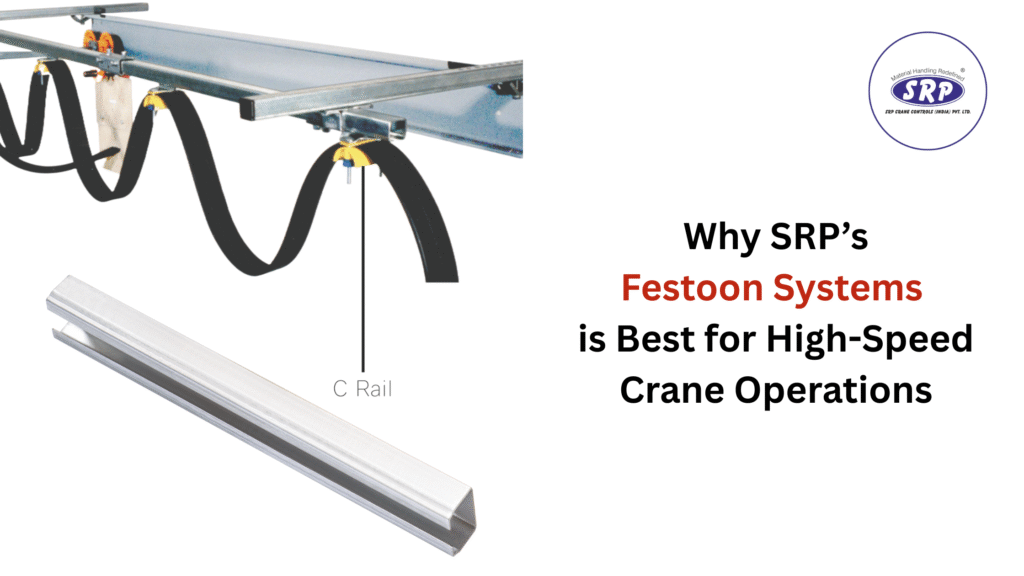
In the bustling world of industrial operations, where every second translates to revenue, high-speed crane systems are the unsung heroes of efficiency. At the heart of these systems lies a critical component often overlooked: the festoon system. While many manufacturers offer solutions in this space, SRP Crane Controls has emerged as the industry’s gold standard. Let’s dissect why their festoon systems dominate high-speed applications—from ports to automated warehouses—and how they’re reshaping material handling globally.

Understanding Festoon Systems: The Backbone of Modern Crane Operations
A festoon system isn’t just a set of cables and trolleys—it’s the central nervous system of any overhead crane. Imagine a high-speed crane in a port: it needs to glide effortlessly, lift multi-ton containers, and transmit real-time data—all while enduring saltwater corrosion and extreme temperatures. Traditional wiring solutions falter under such demands, but SRP’s festoon systems thrive.
At its core, SRP’s design combines three key elements:
- Tracks: Engineered from galvanized steel for rust resistance, these form the “railroad” for cable movement.
- Trolleys: Precision-crafted from composite materials, they reduce friction by 40% compared to conventional steel trolleys.
- Cable Management: SRP’s proprietary “C-Rail” system uses staggered hangers to prevent cable entanglement—a common pain point in high-speed scenarios.
As Ludovic Phan, Global Service Director at Conductix-Wampfler, notes: “Modern festoon systems aren’t just about power transmission; they’re about enabling intelligent, responsive crane movements that traditional systems can’t match”.
Why SRP Outshines Competitors: Five Unmatched Advantages
1. Speed Without Compromise
SRP’s systems enable cranes to operate at 15% higher speeds than industry averages while maintaining precision. How? Their motorized trolleys use predictive algorithms to anticipate directional changes, reducing lag time during abrupt stops or shifts. In a recent retrofit at a Middle Eastern port, this technology cut container handling times by 22 minutes per vessel.
2. Durability That Defies Environments
While standard festoon systems last 3–5 years in harsh conditions, SRP’s ISO 50001-certified manufacturing process yields components with a 10-year operational lifespan. Their secret? A patented polymer coating on cables that withstands temperatures from -40°C to 120°C—critical for Indian foundries and Siberian logistics hubs alike.
3. Safety Through Innovation
Traditional systems account for 34% of crane-related electrical fires. SRP combats this with:
- Explosion-proof trolleys for hazardous environments
- Real-time load monitoring via embedded IoT sensors
- Auto-braking tracks that engage during cable slack
As one port operator testified: “Since switching to SRP, our near-miss incidents dropped by 67% in six months”.

Case in Point: SRP in Action
Revolutionizing Indian Ports
When Mumbai’s JNPT sought to boost throughput by 30%, they turned to SRP. The installation of 42 motorized festoon systems enabled cranes to handle 45 containers/hour—surpassing Singapore and Rotterdam’s averages. The project’s success hinged on SRP’s ability to execute a four-day retrofit per crane without disrupting operations—a feat previously deemed impossible.
Smart Factories, Smarter Cranes
In Pune’s automotive belt, SRP’s DSL Busbar systems now power fully automated production lines. These systems don’t just transmit power—they relay 12,000 data points/minute to central AI controllers, enabling real-time adjustments. The result? A 19% reduction in assembly line downtime across five plants.
The SRP Difference: Engineering Meets Empathy
Certification as a Culture
SRP doesn’t just meet standards—they redefine them. With ISO 14001:2015 for environmental management and ISO 45001:2018 for worker safety, their festoon systems embody holistic excellence. Each component undergoes 117 quality checks—far exceeding the industry’s 23-check average.
Global Reach, Local Insight
From their Rajkot HQ, SRP serves 47 countries while maintaining regional expertise. Their Middle East team, for instance, developed a sand-resistant track system after studying desert wind patterns—a solution now adopted across Gulf ports.
The Future Is Overhead
As India’s construction sector grows at a 15% CAGR, the demand for intelligent crane systems will skyrocket. SRP’s R&D pipeline hints at what’s next:
- Self-healing cables that repair minor insulation breaches
- Hydrogen-powered trolleys for zero-emission ports
- Quantum-encrypted data transmission for hack-proof operations
For startups entering this space, the message is clear: “Adopting SRP isn’t an expense—it’s leverage”. Their systems don’t just keep cranes moving; they propel businesses toward unprecedented efficiency.

In the words of a Surat-based logistics entrepreneur: “Before SRP, our cranes were tools. Now, they’re strategic assets”. As high-speed operations become the global benchmark, SRP’s festoon systems stand ready to power the next industrial revolution—one seamless lift at a time.
